| |

Delhi City Guide
|
|
Delhi, one of India's fastest growing cities, has spread far beyond the "seven cities" created between the 13th and the 17th centuries. It has sprawled over the west bank of the Yamuna and now straddles the river. Remnants of the past survive cheek -by-jowl with skyscrapers, residential colonies and bustling commercial complexes. Delhi has some of the finest museums in the country. Its boutiques and shopping arcades offer access to a wealth of traditional and contemporary crafts from all over the 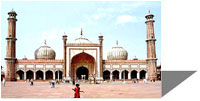 country. It has speciality restaurants to please the gourmet, open parks and gardens ablaze with flowers, and in the winter months particularly, a variety of cultural events. Its many-layered existence is tantalizing and can entice the curious
traveller into a fascinating journey of discovery. New Delhi was built in 1911. It was tobe "conceived with spaciousness and care so that the new creation would be in every way worthy of this ancient and beautiful city". Lutyens and Baker planned a city with wide, tree-lined avenues. The 340-roomed Viceregal Lodge, now the Rashtrapati Bhawan, was raised on Raisina Hill. Nearby are India Gate, a World War I memorial. Parliament House, the prestigious National
Museum and the National Gallery of Modern Art. On Republic Day, Rajpath witnesses a display of pageantry.
Old Delhi
In the Old Delhi, you can visit Feroz Shah Kotla, Shahjahanabad's Red Fort, Jama Masjid, Chandni Chowk and the Raj Ghat. Built by Shah Jahan, Chandni Chowk is the hub of social, cultural and religious life of the Capital.
Nightlife
Apart from historic forts and temples, Delhi has a very interesting nightlife, which offers fun and entertainment such as dance clubs, bars, parties, festivals, shows, restaurants, live music bands and plenty of other activities. Delhi has witnessed tumultuous times, different rulers and dynasties but surprisingly its charm and magnificence is still protected.
|
|
Places of Interest
|
Rajghat
4 km away from Janpath to the N-East of Feroz Shah near Delhi Gate at Rin 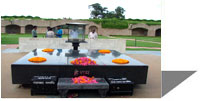 g Rd on the bank of Jamuna situated Rajghat. Jawaharlal Nehru Rd also ends opp. Rajghat. On 31st Jan. 1948, Mahatma Gandhi's last rites was performed here. The memorial stone of Gandhi is square in shape made of black stone. His last ward- 'Hey Ram' is inscribed on it. Ordinary people, VIPs, foreign tourists all come here at Rajghat to pay their homage to him.
Red Fort
Another marvel of architecture is the Red Fort and it could perhaps be singled out as yet another monument, which should not escape the tourist's eyes. Known as lal qila (lal means red and qila means fort). It is laid out along the river Yamuna as an irregular octagon. It is surrounded by a wall of about 2.4 Kilometers in circumference and is built of Red Sandstone. The Mughal King Shah Jahan transferred his capital from Agra to Delhi and the fort was completed in 1648, nine years after the king shifted to this city. The fort has two main entrances, the Delhi Gate and the Lahori Gate, which faces the famed Chandni Chowk market.
Lotus Temple 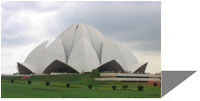
Is a very recent architectural marvel of the Bahai faith and is visible from several spots in south Delhi. Located in Kalkaji in the south of Delhi, it is lotus shaped and has rightly been given the name. It is made of marble, cement, dolomite and sand. It is open to all faiths and is an ideal place for meditation and obtaining peace and tranquility.
Akshardham Temple 
The temple is built on the lines of the Akshardham Temple in Gandhinagar (Gujarat). The temple complex promises a unique view of the Hindu religion and Indian culture. Lying in the wide-open 100 acres of land, amidst luxuriant lawns adorned with water fountains and carved pavilions, the temple complex stand imposingly on the banks of the serene River Yamuna. A huge amount of 2 billions have been spent to raise this grand place of worship. The main monument is about 141-ft high and houses a striking statue of Lord Swaminarayan.
|
Qutub Minar
The tallest stone tower of India - Qutub Minar is one of the most visited spots in Delhi. B 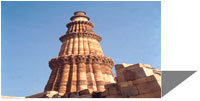 uilt in 1199 by Qutub-ud-Din, the Qutub Minar is the first Islamic structure built in India. The construction of this historical tower was commenced by Qutub-ud-Din-Aibak and completed by his successor and son in law Iltutmish. Qutub Minar is one of the finest Islamic structures ever raised in India
India Gate
This massive archway was designed and built by Lutyens, and originally known as All India War Memorial in memory of the 90,000 Indian soldiers who died in the campaigns of World War I, the North-West Frontier operations of the same time and the 1919 Afghan Fiasco. The names of all the soldiers are inscribed on the walls of the gate.
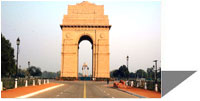 How to reach
How to reach
- Air
The Indira Gandhi International Airport is a few km further from the domestic terminal. Domestic and international airlines connect Delhi with all parts of the country and the world.
- Rail
Delhi is connected to almost every city and town of the country by rail.
- Road
Delhi is well connected to all major towns and cities of the country with a network of national and state highways.
|
|
|
|
| |
|
< |
|
| |
|
|